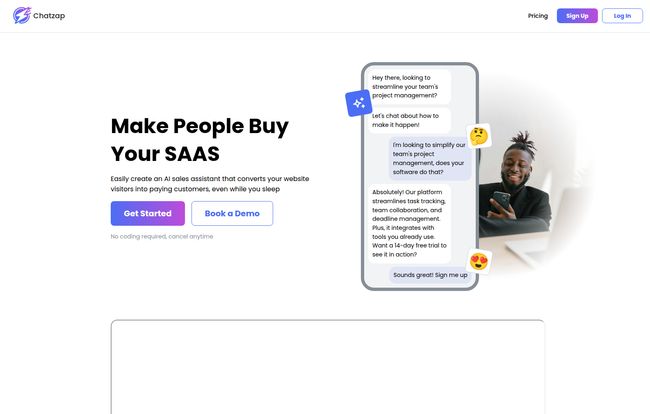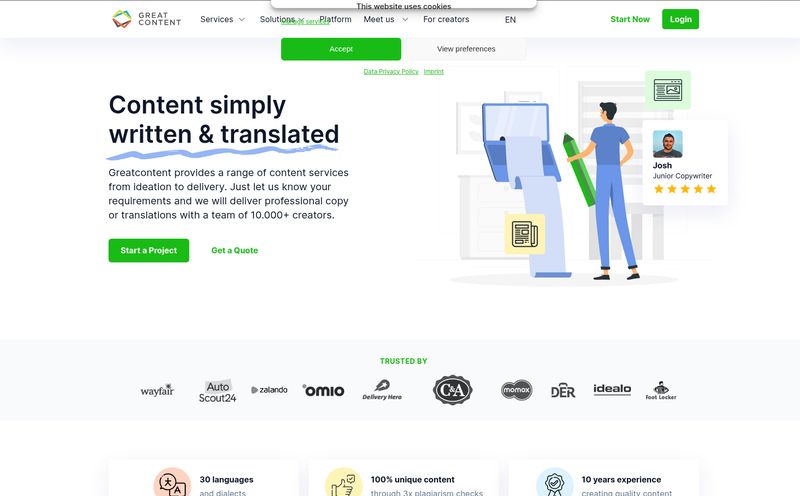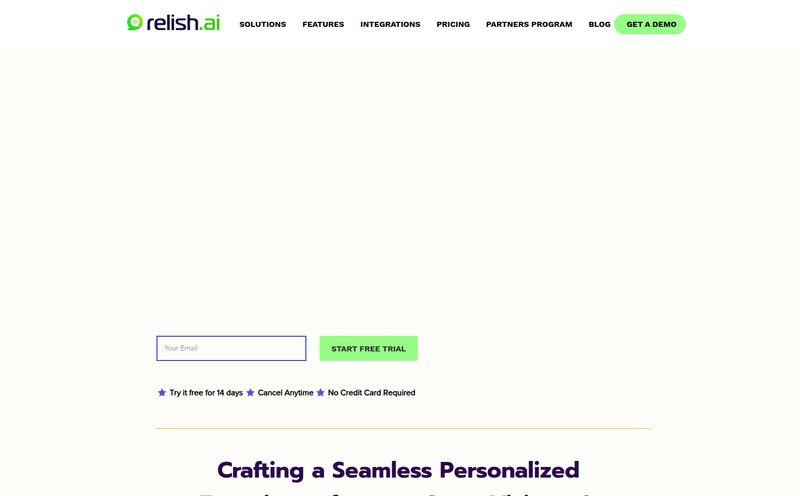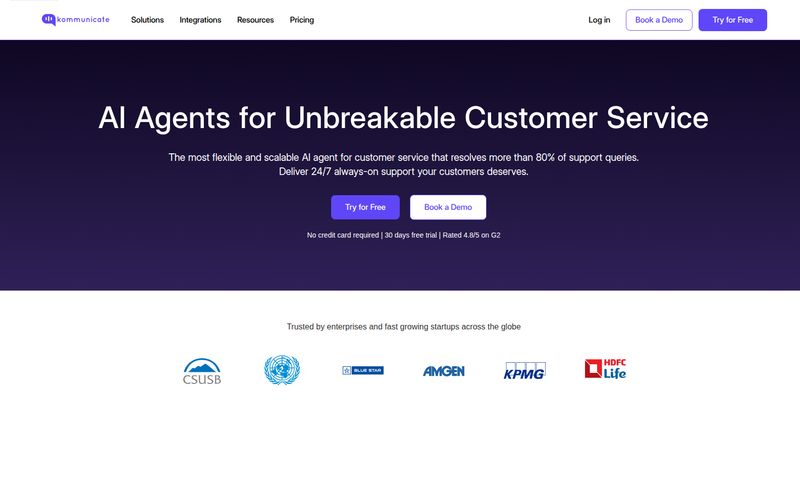You’ve spent countless hours, and probably a decent chunk of change, on driving traffic to your website. You’ve tweaked your SEO, you've dabbled in CPC campaigns, and you watch your Google Analytics like a hawk. People are visiting. Hooray! But then… crickets. They browse, they click around, and then they vanish into the digital ether. It’s like throwing a great party but nobody stays to chat.
For SaaS founders and marketers, this is a special kind of pain. Every visitor is a potential customer, a potential evangelist for your product. But you can't be there 24/7 to answer every little question that pops into their head at 2 AM. Or can you?
We've Come a Long Way from "Clippy"
I’ve been in this game for a while, and I remember the early days of chatbots. Clunky, script-based things that felt more like an automated phone tree than a real conversation. You’d ask a simple question, and it would reply with, “I’m sorry, I don’t understand. Please choose from the following options.” Ugh. It was often more frustrating than helpful.
But the tech has grown up. A lot. We're now in the era of AI that can genuinely understand context and provide meaningful answers. This is where tools like Chatzap are starting to make some serious waves, and frankly, I was curious to see if it lived up to the hype.
So, What Exactly is Chatzap?
Imagine if you could take your best, most knowledgeable salesperson—the one who knows your product inside and out—and clone them. Then, you put that clone on your website, ready to greet and help every single visitor, any time of day or night. That’s the core idea behind Chatzap.
In simple terms, Chatzap is an AI sales assistant. You don't program it with a bunch of “if-then” scenarios. Instead, you just tell it to read your website. It gobbles up all the information on your pages—features, benefits, pricing, documentation—and uses that knowledge to build its brain. From there, it can hold intelligent, personalized conversations with your visitors, answering their specific questions in real time.

Visit Chatzap
It’s designed to turn those passive browsers into engaged leads, and hopefully, into paying customers. All while you sleep, or focus on, you know, actually building your product.
Making Your Website Work Smarter, Not Harder
The promise of automation is always alluring, but how does this thing actually get the job done? It boils down to a few clever mechanics.
The Magic is in the Machine Reading
The whole system hinges on Chatzap’s ability to learn from your existing content. This is both its biggest strength and its most important caveat. On one hand, the setup is incredibly fast. You're not spending a week scripting conversations. On the other hand, its effectiveness is directly tied to the quality of your website’s copy. If your site is vague, confusing, or outdated, your chatbot will be too. Garbage in, garbage out, as the old saying goes. So, think of this as a great excuse to finally do that content audit you’ve been putting off.
A Global Handshake in 95 Languages
This is a feature that really caught my eye. Chatzap supports 95 languages. For any SaaS business with global ambitions, this is massive. You can offer instant, personalized support to a potential customer in Tokyo or Berlin just as easily as you can to someone in Texas. It breaks down a huge barrier to entry for international markets without you needing a multilingual support team on standby.
Turning "Just Browsing" into a Solid Lead
Here’s where it connects to the bottom line. The chatbot isn't just there to be a friendly face; it’s there to do a job. Chatzap has built-in lead collection. When a visitor has their questions answered and is showing buying signals, the bot can prompt them for their contact info. This plugs a major leak in the typical sales funnel. Instead of a visitor leaving and maybe, maybe coming back later, you capture their details for a follow-up. That's money you're no longer leaving on the table.
The Real Scoop: What I Like and What You Should Know
No tool is perfect, right? So let's get into the nitty-gritty. After playing around with it and looking at the specs, here's my honest take.
The good stuff is pretty obvious. The 24/7 automated assistance is a game-changer for small teams. Giving every visitor a personalized, VIP-style experience is something that used to require a huge sales team. The multi-language support is a killer feature. And the potential ROI from capturing leads that would have otherwise bounced is huge.
Now for the heads-ups. As I mentioned, it relies entirely on your website content. This isn't really a 'con' so much as a prerequisite—you need to have your house in order for the bot to be a good host. The bigger thing to note is that some features are still on the roadmap. API access and detailed analytics are listed as “coming soon.” For a data junkie like myself, not having analytics from day one is a bit of a bummer, but it's good they're being transparent about it. It just means you’re betting on the future development of the platform, which, given its solid foundation, seems like a reasonable bet to me.
Chatzap Pricing: How Much for an AI Employee?
Alright, lets talk turkey. The pricing structure is refreshingly straightforward, which I always appreciate. They have a few tiers, and it's pretty clear who each one is for.
Here's a quick breakdown:
| Plan | Price | Key Features |
|---|---|---|
| Free | $0 / month | 1 chatbot, 100 messages/month, 400k character limit for training. |
| Basic | $59 / month | 1 chatbot, 2,000 messages/month, 11M character limit. |
| Premium | $189 / month | 5 chatbots, 10,000 messages/month, VIP support, remove branding. |
My take? The Free plan is a genuine free plan, not just a crippled trial. 100 messages are enough to see if it works for your audience without pulling out your credit card. The Basic plan feels like the sweet spot for most growing SaaS businesses or solopreneurs. The jump to 11 million characters for training means it can read your entire site, docs, and blog combined. The Premium plan is for the big players—agencies managing multiple clients or larger companies with several products that need separate chatbots.
They also have add-ons for more message credits or chatbots, so it scales nicely.
You Can Get This Running Before Your Coffee Gets Cold
One of the biggest barriers to adopting new tech is a complicated setup. I've abandoned tools before because getting them to work felt like a second job. Chatzap seems to have dodged that bullet completely. The process is advertised as being just a few minutes, and it looks it.
- Scan your website: You literally just give it your URL.
- Add the chatbot: You get a snippet of code to paste onto your site. If you've ever installed Google Analytics, you can do this.
- Go Live: That's it. Your new AI assistant is on the clock.
The lack of a complex, code-heavy implementation is a massive win, especially for non-technical founders who just want tools that work out of the box.
Is Chatzap the Right Tool for You?
So, who should be rushing to sign up? Obviously, SaaS companies are the bullseye target audience. The model is perfect for explaining complex features, comparing pricing tiers, and capturing high-intent leads.
But I think the application is broader. Course creators with detailed sales pages could use it to answer student questions. B2B service agencies with in-depth case studies could use it to qualify prospects. Basically, if your business relies on a content-rich website to sell, Chatzap could be a very powerful addition to your toolkit.
Who is it not for? If your website is a simple, one-page digital business card with very little text, the AI won't have much to learn from. It needs substance to provide substance.
Answering Your Burning Questions about Chatzap
I dug through their FAQs and thought of a few more questions you might have.
- Is there really a free plan?
- Yep. You can create one chatbot trained on up to 400k characters and get 100 message credits a month to test it out. It's a great way to see the value firsthand.
- What exactly counts as a "message credit"?
- Any message sent to the chatbot, whether it's from a visitor or even you testing it, deducts one credit. Simple as that.
- How many websites can I use this on?
- Your chatbot credits are pooled across your account. This means you can embed the same chatbot on multiple sites if you want, as long as the training data is relevant to all of them.
- What if my website content is a bit… messy?
- This is a great question. My advice would be to use the rollout of Chatzap as motivation to clean up your key pages. Focus on making sure your product, pricing, and feature pages are clear and accurate. The bot will only be as good as its training material.
- How does this compare to bigger platforms like Intercom or Drift?
- It's a different beast. Intercom and Drift are comprehensive customer communication platforms with live chat, email marketing, and huge feature sets. Chatzap is laser-focused on one thing: automated, AI-driven sales assistance. It's less of an all-in-one suite and more of a specialized, powerful tool. It's simpler, likely much cheaper for this specific function, and designed to be almost entirely hands-off.
The Final Verdict on Chatzap
So what's the bottom line? I'm optimistic. Chatzap is a smart, focused tool that solves a very real problem for a lot of online businesses. It lowers the barrier to providing instant, high-quality engagement and does it in a way that is incredibly easy to set up.
Yes, I'm eager to see the analytics and API features roll out. But what's already here is compelling. The ability to create a knowledgeable sales assistant from your existing website content in minutes is powerful stuff.
If you're a SaaS company or any business with a solid website, I think giving the free plan a spin is a no-brainer. You might be surprised by how many valuable conversations you've been missing.



